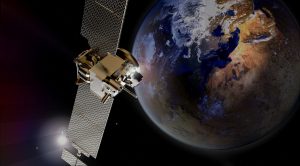Mario Livio’s Books
- Posted by Steve Philips
- Posted on December 11, 2017
- Space
- Comments Off on Mario Livio’s Books
If you go to Mario Livio’s Amazon page, you’ll find a whole lot of papers and documents released as part of the Space Telescope Science Institute Symposium Series. But you’ll also find six books written by Dr. Livio between 2000 and 2017. Books about a wide range from subjects, from space to mathematics, from history to psychology. But they’re not like most books of their kind – the author is able to easily explain complex and mind-numbing concepts, ideas, theories and facts in a way that’s extremely easy to understand and relate to. Let’s take a brief look at each of his books and see exactly what makes them special and why so many people around the world enjoy them.
The Accelerating Universe (2000)
 At the time of the book’s release (2000), the discovery that the Universe wasn’t contracting, but actually expanding – and rapidly, too – was a relatively new one, throwing a whole lot of theories and ideas about the universe that we had taken as fact into question. In his book “The Accelerating Universe”, Mario Livio takes various popular and not-so-popular theories about the cosmos, the universe and even the multiverse and explains them clearly to the reader without the use of jargons or etymology. Present throughout the book is the idea that theories can be classified as “beautiful” or not based on objective scientific principles, which, of course, Dr. Livio does for all of the theories found within.
At the time of the book’s release (2000), the discovery that the Universe wasn’t contracting, but actually expanding – and rapidly, too – was a relatively new one, throwing a whole lot of theories and ideas about the universe that we had taken as fact into question. In his book “The Accelerating Universe”, Mario Livio takes various popular and not-so-popular theories about the cosmos, the universe and even the multiverse and explains them clearly to the reader without the use of jargons or etymology. Present throughout the book is the idea that theories can be classified as “beautiful” or not based on objective scientific principles, which, of course, Dr. Livio does for all of the theories found within.
The Golden Ratio (2003)
While not too many people know exactly what it is, most have heard the term “golden ratio” used in one context or another, and it’s all thanks to Mario Livio’s book, which became an international bestseller that popularized the concept. The golden ratio, or “phi”, is an infinite number that’s roughly half of Pi. It can be found, in one way or another, all across the world, in both man-made structures and organic life. The Greek Parthenon, a snail’s shell and even the shape of a hurricane when viewed from space all adhere fantastically to the Golden Ratio, proving that this phenomenon is universal and highly fascinating. “The Golden Ratio” brought Dr. Livio’s name into the spotlight, and won the Peano Prize in 2003 International Pythagoras Prize in 2004, recognizing it as the best book about mathematics of that time.
The Equation That Couldn’t Be Solved (2006)
 This isn’t Dr. Livio’s most popular book, but it’s most certainly the one where, following the smashing success of “The Golden Ratio”, he further cemented his very particular style and tone. “The Equation That Couldn’t Be Solved” follows the story of the Quintic Function – a notably difficult equation that gave several mathematicians trouble before it was finally solved. Dr. Livio follows the lives of these people, giving us the biographical information and anecdotes we as readers require to understand their struggles. This mix of a narrative, mathematics and history is what has distinguished Dr. Livio’s books from all the others like them.
This isn’t Dr. Livio’s most popular book, but it’s most certainly the one where, following the smashing success of “The Golden Ratio”, he further cemented his very particular style and tone. “The Equation That Couldn’t Be Solved” follows the story of the Quintic Function – a notably difficult equation that gave several mathematicians trouble before it was finally solved. Dr. Livio follows the lives of these people, giving us the biographical information and anecdotes we as readers require to understand their struggles. This mix of a narrative, mathematics and history is what has distinguished Dr. Livio’s books from all the others like them.
Is God A Mathematician? (2010)
The reason why astronomers and astrophysicians know so much about the universe is not because they’ve been able to physically go to various planets and stars (like supernovas or black holes) and measure them the way that scientists examine objects on Earth. No, they calculate things like the mass of various planets or the distance between them based on math, which seems to be the one constant in the entire Universe, to the point where, if we ever make contact with an alien species, chances are the only thing we’ll have in common is math. With that said, the question remains – is math invented or discovered? “Is God A Mathematician” was extremely well-received, and was eventually adapted into an Emmy-nominated program called “The Great Math Problem”.
Brilliant Blunders (2014)
 Probably the most straightforward of Mario Livio’s books, and the one that’s lightest on mathematical and astronomical concepts. The only thing discussed in it are anecdotes about, arguably, the greatest scientists in history, like Einstein, Newton and Darwin… Or, more specifically, their failures. People tend to imagine these great men as infallible (there’s multiple stories online about some ordinary student who says something profound about life or the universe, only for the end of the story to reveal that his name was Albert Einstein), but that’s, obviously, extremely far from the truth. And reading the book narrated by someone who knows his stuff and is able to look at history from a modern perspective truly makes it obvious just how much these otherwise brilliant people were off the target on these subjects – and in some cases, they were REALLY wrong (like, for example, William Thomson – also known as Lord Kelvin – calculated the Earth’s age… And came about 50 times short).
Probably the most straightforward of Mario Livio’s books, and the one that’s lightest on mathematical and astronomical concepts. The only thing discussed in it are anecdotes about, arguably, the greatest scientists in history, like Einstein, Newton and Darwin… Or, more specifically, their failures. People tend to imagine these great men as infallible (there’s multiple stories online about some ordinary student who says something profound about life or the universe, only for the end of the story to reveal that his name was Albert Einstein), but that’s, obviously, extremely far from the truth. And reading the book narrated by someone who knows his stuff and is able to look at history from a modern perspective truly makes it obvious just how much these otherwise brilliant people were off the target on these subjects – and in some cases, they were REALLY wrong (like, for example, William Thomson – also known as Lord Kelvin – calculated the Earth’s age… And came about 50 times short).
Why? What Makes Us Curious (2017)
Dr. Livio’s latest book is about psychology, and thus may feel like a far cry from his previous work on space and mathematics… But, in an odd way, it’s related to every single scientific discovery ever made. After all, it’s our unnatural sense of curiosity – something that we don’t share with many other animals – that makes us look into the various phenomena that surround us on Earth and beyond and pushes us to create our own. In the book, Dr. Livio identifies various different types of curiosity, outlines studies discussing the subject and its connection to memory and learning and, true to his classic style, outlines historical anecdotes to prove how various scientists and researchers throughout history used their curiosity to fuel their scientific advances. Receiving praise from everyone, from various publications (such as the New York Times, which featured it on its pages) to accomplished scientists (like Nobel Prize winner Adam Reiss, who calls it a “fascinating quest to understand the origin and mechanisms of our curiosity”). As of the time of this writing, “Why” is brand new, so we can only wait and see what accolades it’s going to receive over its lifetime.
